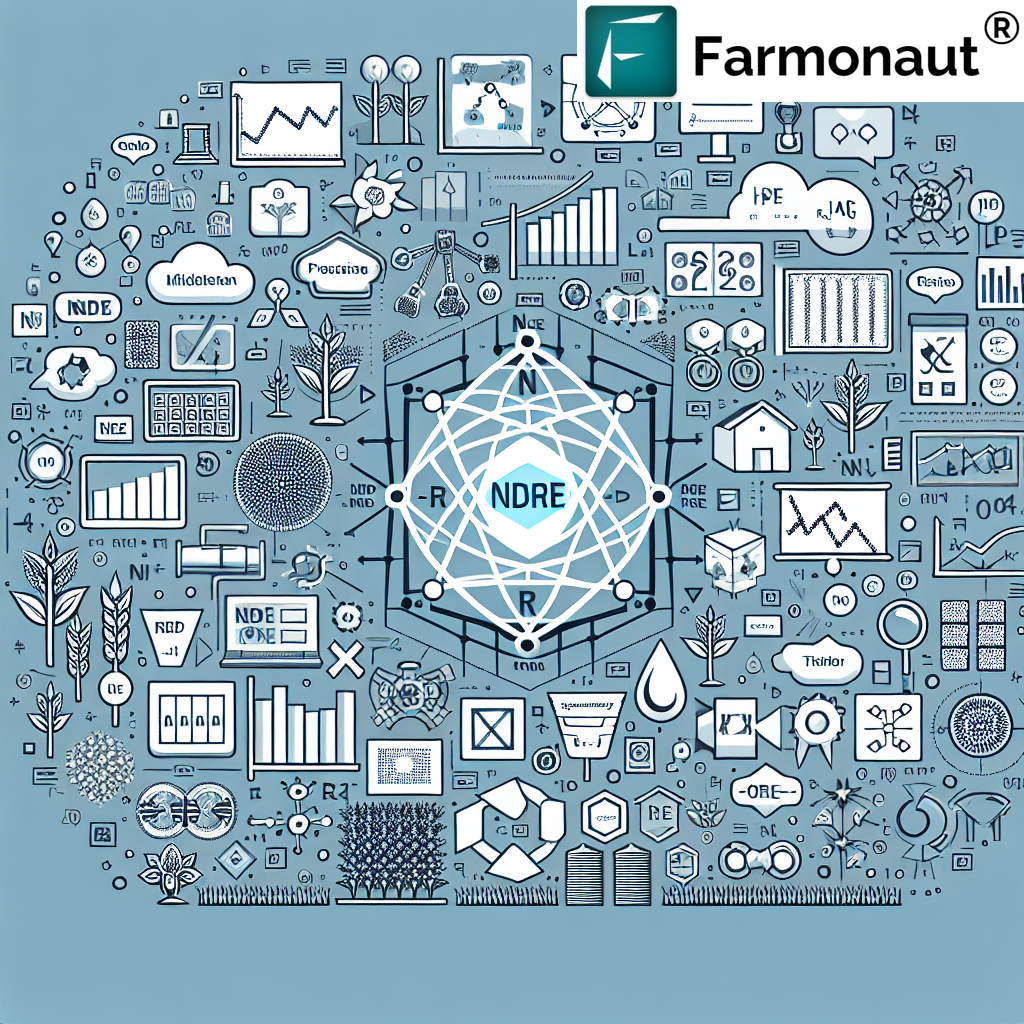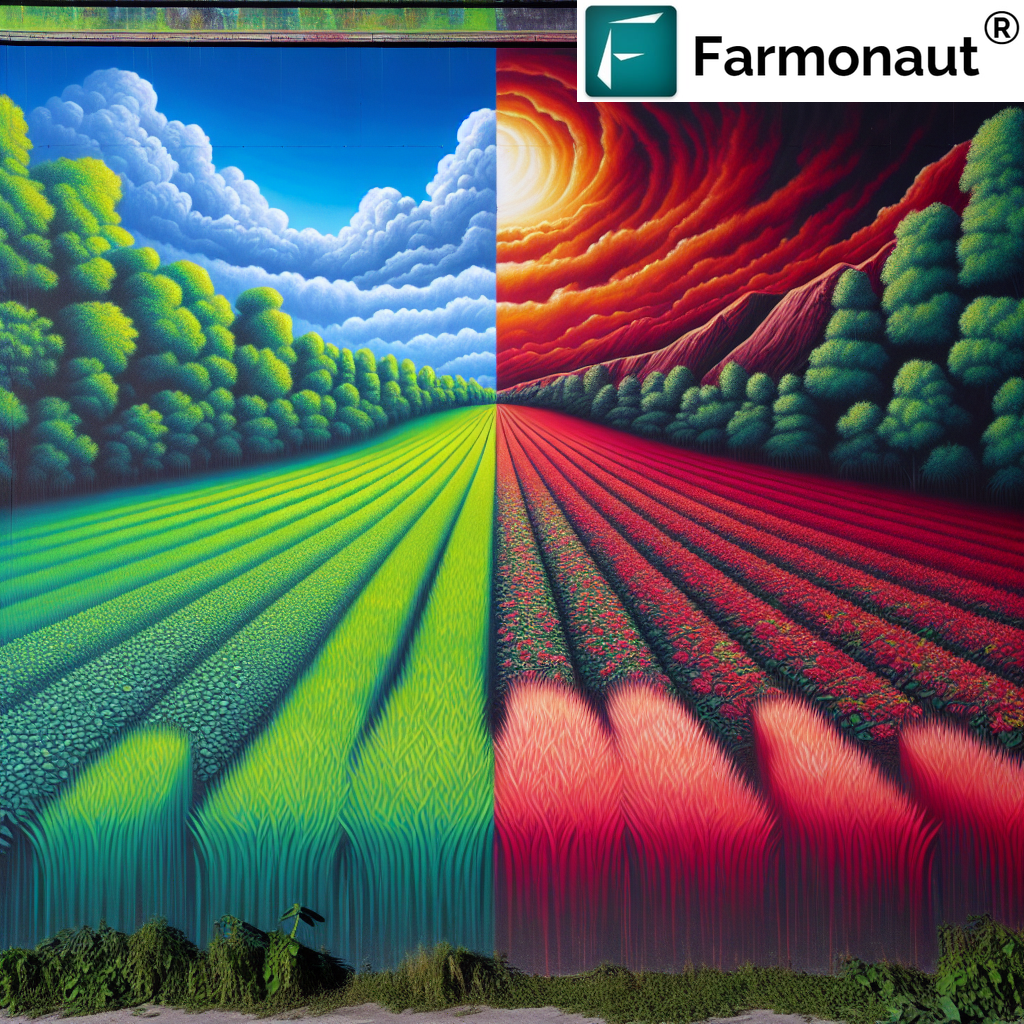Mastering the NDRE Formula: Unlocking Precision Agriculture with Farmonaut

In the ever-evolving landscape of precision agriculture, understanding and utilizing advanced vegetation indices has become crucial for maximizing crop yields and optimizing resource management. Among these indices, the Normalized Difference Red Edge (NDRE) index stands out as a powerful tool for assessing crop health and vigor. At Farmonaut, we’re committed to helping farmers and agronomists harness the full potential of this innovative technology. In this comprehensive guide, we’ll delve deep into the NDRE formula, its applications, and how it’s revolutionizing modern farming practices.
Table of Contents
- Understanding the NDRE Index
- The NDRE Formula Explained
- Applications of NDRE in Precision Agriculture
- Farmonaut’s Approach to NDRE Analysis
- Comparing NDRE with Other Vegetation Indices
- Implementing NDRE in Your Farming Practices
- Case Studies and Success Stories
- Future Trends in Vegetation Indices
- FAQs about NDRE
1. Understanding the NDRE Index
The Normalized Difference Red Edge (NDRE) index is an advanced vegetation index that provides valuable insights into plant health, chlorophyll content, and nitrogen status. Unlike its predecessor, the Normalized Difference Vegetation Index (NDVI), NDRE is particularly sensitive to variations in chlorophyll content, making it an excellent tool for assessing crop vigor and stress levels.
Why NDRE Matters in Precision Agriculture
- Enhanced sensitivity to chlorophyll variations
- Better performance in dense canopy conditions
- Improved early detection of crop stress
- More accurate nitrogen management capabilities
At Farmonaut, we’ve integrated NDRE analysis into our satellite-based crop health monitoring system, allowing farmers to access this powerful tool easily and affordably.
2. The NDRE Formula Explained
The heart of NDRE analysis lies in its formula. The NDRE formula is a mathematical expression that compares the reflectance of near-infrared (NIR) light to that of red edge light. Here’s the NDRE index formula:

NDRE = (NIR – Red Edge) / (NIR + Red Edge)
Where:
- NIR = Reflectance in the near-infrared band
- Red Edge = Reflectance in the red edge band
The NDRE formula yields values between -1 and 1, with higher values indicating healthier vegetation and lower values suggesting stressed or unhealthy plants.
Breaking Down the NDRE Formula
To truly understand the power of the NDRE index formula, let’s break it down:
- Near-Infrared (NIR) Band: Healthy plants reflect a large amount of NIR light due to their internal leaf structure.
- Red Edge Band: This narrow band of wavelengths is highly sensitive to changes in chlorophyll content.
- Normalization: The formula normalizes the difference between NIR and Red Edge reflectance, allowing for comparisons across different lighting conditions and plant types.
By leveraging this formula, Farmonaut’s satellite-based monitoring system can provide farmers with accurate, timely information about their crops’ health and nitrogen status.
3. Applications of NDRE in Precision Agriculture
The NDRE index has a wide range of applications in modern agriculture. At Farmonaut, we’ve seen firsthand how this powerful tool can transform farming practices:
- Nitrogen Management: NDRE is highly sensitive to changes in chlorophyll content, making it an excellent indicator of nitrogen status in crops.
- Early Stress Detection: The index can detect subtle changes in plant health before they become visible to the naked eye.
- Yield Prediction: By correlating NDRE values with historical yield data, farmers can make more accurate yield predictions.
- Variable Rate Application: NDRE maps can guide precision application of fertilizers and other inputs, optimizing resource use.
- Crop Phenology Monitoring: The index helps track crop growth stages, informing critical management decisions.
Our Jeevn AI Advisory System incorporates NDRE data to provide personalized, actionable insights for farmers, helping them make informed decisions about their crops.
4. Farmonaut’s Approach to NDRE Analysis
At Farmonaut, we’ve revolutionized the way farmers access and utilize NDRE data. Our approach combines cutting-edge satellite technology with advanced AI algorithms to deliver accurate, timely, and actionable NDRE insights.
Key Features of Farmonaut’s NDRE Analysis:
- High-Resolution Satellite Imagery: We use state-of-the-art satellites to capture detailed NDRE data across vast agricultural areas.
- AI-Powered Analysis: Our Jeevn AI system processes NDRE data to provide personalized recommendations for each field.
- User-Friendly Interface: Farmers can easily access NDRE maps and insights through our web and mobile apps.
- Historical Data Tracking: Compare current NDRE values with historical data to identify trends and anomalies.
- Integration with Other Indices: We combine NDRE with other vegetation indices for a comprehensive view of crop health.
To experience the power of our NDRE analysis firsthand, visit Farmonaut’s App or explore our API documentation for developers.
5. Comparing NDRE with Other Vegetation Indices
While NDRE is a powerful tool, it’s essential to understand how it compares to other vegetation indices. Here’s a quick comparison:
| Index | Strengths | Limitations |
|---|---|---|
| NDRE |
– High sensitivity to chlorophyll content – Effective in dense canopies – Good for nitrogen management |
– Requires specific sensor capabilities – More complex interpretation |
| NDVI |
– Widely used and understood – Good for general vegetation health |
– Saturates in dense canopies – Less sensitive to subtle changes |
| EVI |
– Improved performance in high biomass regions – Reduces atmospheric influences |
– More complex calculation – Requires blue band data |
At Farmonaut, we utilize a combination of these indices to provide a comprehensive view of crop health, with NDRE playing a crucial role in our advanced analytics.
6. Implementing NDRE in Your Farming Practices
Integrating NDRE analysis into your farming operations can significantly enhance your decision-making process. Here’s how you can get started with Farmonaut:
- Sign Up: Create an account on the Farmonaut platform.
- Define Your Fields: Use our intuitive mapping tool to outline your fields.
- Access NDRE Maps: Regularly check your field’s NDRE maps for insights.
- Interpret the Data: Use our AI-powered recommendations to understand what the NDRE values mean for your crops.
- Take Action: Implement targeted interventions based on the NDRE insights.
- Track Progress: Monitor changes in NDRE values over time to assess the impact of your management decisions.
Download our mobile app for on-the-go access to NDRE data:
7. Case Studies and Success Stories
The power of NDRE analysis is best illustrated through real-world examples. Here are a few success stories from Farmonaut users:
Case Study 1: Precision Nitrogen Management in Wheat
A large-scale wheat farmer in the Midwest used Farmonaut’s NDRE maps to optimize nitrogen application. By identifying areas of low NDRE values, they were able to apply nitrogen more precisely, resulting in a 15% increase in yield and a 20% reduction in fertilizer costs.
Case Study 2: Early Detection of Crop Stress in Soybeans
A soybean farmer in Brazil utilized our NDRE analysis to detect early signs of nutrient deficiency. The early intervention guided by NDRE data prevented potential yield loss and saved an estimated 30% in treatment costs.
Case Study 3: Improving Irrigation Efficiency in Vineyards
A vineyard in California used Farmonaut’s NDRE maps in conjunction with soil moisture data to optimize irrigation schedules. This integrated approach led to a 25% reduction in water usage while maintaining grape quality.
These case studies demonstrate the versatility and effectiveness of NDRE analysis in various agricultural contexts. By leveraging Farmonaut’s technology, farmers can achieve similar results in their own operations.
8. Future Trends in Vegetation Indices
As technology continues to advance, we at Farmonaut are always looking ahead to the future of vegetation indices and precision agriculture. Here are some trends we’re watching closely:
- Hyperspectral Imaging: The development of satellite-based hyperspectral sensors will allow for even more detailed vegetation analysis.
- AI and Machine Learning: Advanced algorithms will improve the interpretation of NDRE and other indices, providing more accurate and personalized recommendations.
- Integration with IoT Devices: Combining satellite-based NDRE data with ground-level sensors will offer a more comprehensive view of crop health.
- Automated Decision Support Systems: AI-powered systems will use NDRE data to automate certain farming decisions, such as irrigation and fertilization.
- Climate Change Adaptation: NDRE and other indices will play a crucial role in helping farmers adapt to changing climate conditions.
At Farmonaut, we’re committed to staying at the forefront of these technological advancements, ensuring that our users always have access to the most cutting-edge tools in precision agriculture.
9. FAQs about NDRE
To further clarify the concept and application of NDRE, we’ve compiled a list of frequently asked questions:
Q1: How is NDRE different from NDVI?
A: While both are vegetation indices, NDRE uses the red edge band instead of the red band used in NDVI. This makes NDRE more sensitive to changes in chlorophyll content and less prone to saturation in dense canopies.
Q2: Can NDRE be used for all crop types?
A: NDRE is effective for a wide range of crops, particularly those with dense canopies. However, its effectiveness may vary depending on the crop’s growth stage and specific characteristics.
Q3: How often should I monitor NDRE values?
A: We recommend monitoring NDRE values at least weekly during critical growth stages. Farmonaut’s satellite-based system provides regular updates, allowing for timely interventions.
Q4: Can NDRE detect specific plant diseases?
A: While NDRE can detect general plant stress, it’s not specific to particular diseases. However, when combined with other data and expert knowledge, it can help in early disease detection.
Q5: How accurate is satellite-based NDRE compared to drone or ground-based measurements?
A: Satellite-based NDRE measurements have shown high correlation with ground-based and drone measurements. The advantage of satellite data lies in its ability to cover large areas consistently and frequently.
Q6: How does Farmonaut ensure the accuracy of its NDRE data?
A: We use high-resolution satellite imagery and advanced processing algorithms to ensure data accuracy. Our system also incorporates ground-truthing and continuous calibration to maintain high standards of precision.
Q7: Can NDRE help in carbon footprint reduction?
A: Yes, by optimizing fertilizer use and improving overall crop management, NDRE-based insights can contribute to reduced carbon footprints in agriculture. This aligns with Farmonaut’s commitment to promoting sustainable farming practices.
Conclusion: Embracing the Power of NDRE with Farmonaut
The Normalized Difference Red Edge (NDRE) index represents a significant advancement in precision agriculture, offering farmers and agronomists a powerful tool for optimizing crop management. By leveraging the NDRE formula and its applications, agricultural professionals can make more informed decisions, leading to improved yields, reduced input costs, and more sustainable farming practices.
At Farmonaut, we’re committed to making this advanced technology accessible and actionable for farmers of all scales. Our satellite-based monitoring system, combined with AI-powered analytics, brings the power of NDRE analysis to your fingertips. By integrating NDRE data with other critical agricultural insights, we provide a comprehensive solution for modern farming challenges.
As we look to the future, the role of vegetation indices like NDRE in agriculture will only grow. With ongoing advancements in satellite technology, AI, and data analytics, the potential for precision agriculture is boundless. Farmonaut is proud to be at the forefront of this agricultural revolution, empowering farmers with the tools and insights they need to thrive in an ever-changing world.
Ready to harness the power of NDRE for your farm? Sign up for Farmonaut today and take the first step towards more precise, efficient, and sustainable agriculture.
For more information on our API and developer resources, visit our API documentation.
Join us in revolutionizing agriculture with the power of NDRE and advanced satellite technology. Together, we can build a more sustainable and productive future for farming.

